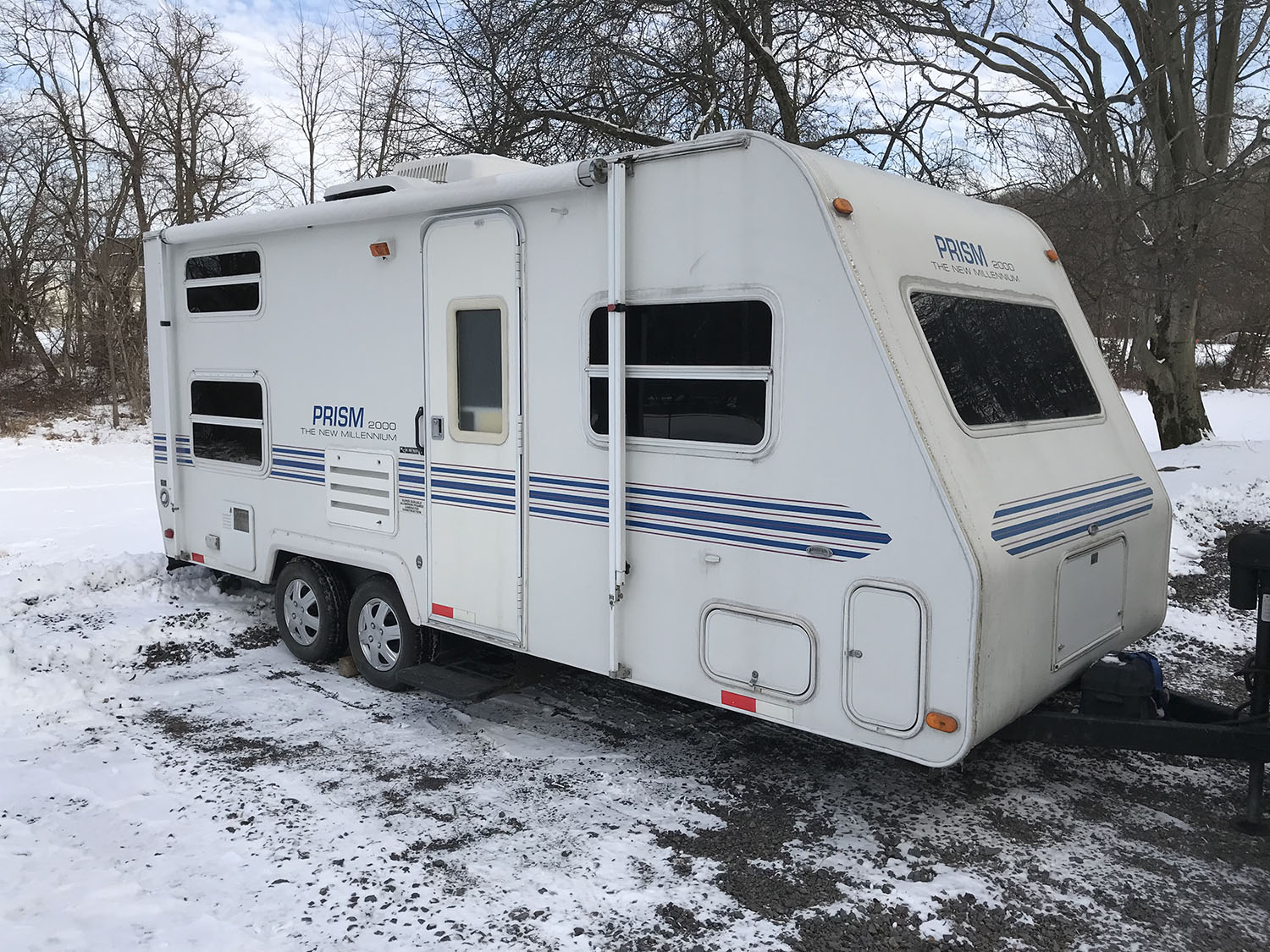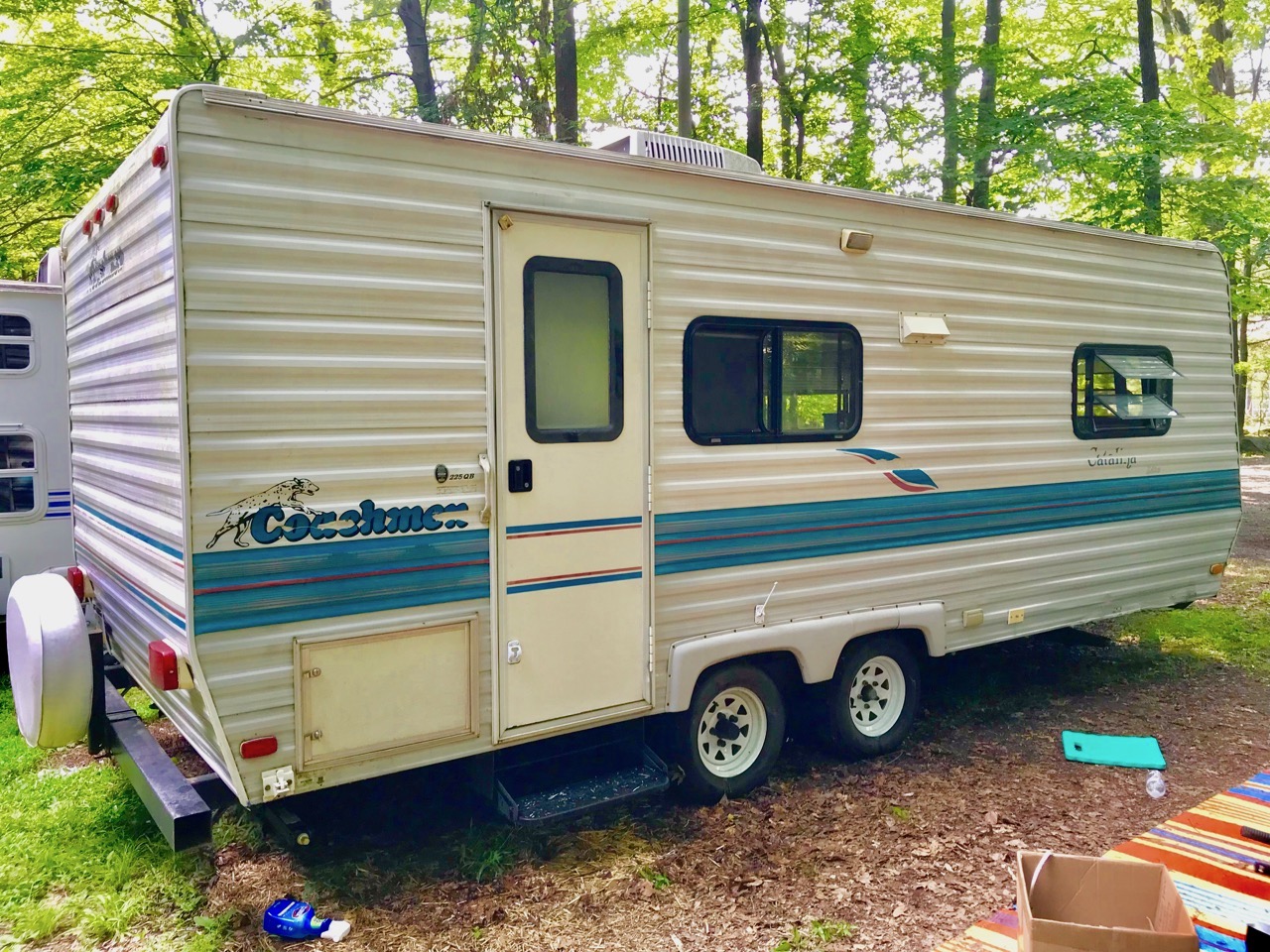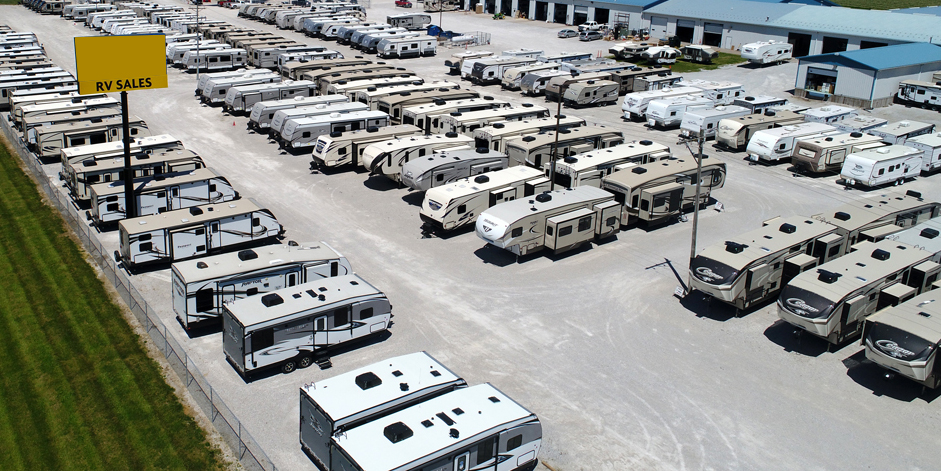Getting Started
Now well into my second year as a fulltime RV dweller, I have begun to get questions from my fellow nomads about my experience buying travel trailers. I’m on my second one right now, and to be honest, the best educational value I can offer is to use my experience as a cautionary tale. Both with my first and second trailers, I made a LOT of really stupid, unnecessary mistakes. They all cost me dearly in lost time, money, and mostly comfort. So pretty much everything I’m going to recommend to you here is stuff I either didn’t do, did do but not well enough, or simply was misinformed about.
That said, I did make it through my whole first year without getting too badly hurt or dying due to stupid decisions, so I feel qualified—in fact, especially qualified—to tell you what really matters in choosing a travel trailer and what isn’t so critical. Of course, everyone’s needs vary, and even those can change once you get on the road. But there are certain considerations every trailer dweller must attend to, so we’ll start from there and drill down to the more granular details.
As always, I remind you that nothing I recommend is gospel. I share what I have learned based on my own experience, and your mileage may vary. Also, my thoughts are just that—ruminations—and not to be considered technical or legal advice. Use this information at your own risk.

This is Wildheart I, my first rig, a 1996 Thor Prism MP-20. That 20 stands for the overall length of the rig, including the 3-foot tongue, which means the living cabin was 7′ x 17′ — and yes, it was as small as it sounds. But it got me through my first year as a fulltimer.
Get Organized
So, let’s start with an organizational plan, because one thing I know for sure is that the most daunting prospect of the entire process of becoming a fulltimer is knowing where to start. Getting stalled at that point is the likely cause of most of the deaths of people’s nomadic dreams. And sadly, it’s SO unnecessary! One good thing about my own process was that I knew this, because by nature I am a scattered, haphazard thinker. But as a professional writer, I have learned that to go from idea to finished project—be that a source interview, an article or a full-length book—it’s imperative to establish the Three Ps:
- Project
- Plan
- Process
Project
The project defines Point A and Point B; where you’re starting from and where you want to go. It seems like a no-brainer, but so many people start working on something without having a clear idea of their actual goal.
Plan
The plan is your outline for steps to get from Point A to Point B. Think of it as a roadmap. Do you absolutely need this? No. You can stumble along, making all kinds of false starts and having to backtrack, re-do work you’ve already done because it took you down a blind alley, etc. Personally, there’s almost nothing I hate as much as having to re-do something I thought I’d already accomplished. So as much as my natural tendencies are to scorn anything that inhibits my spontanaeity, I have learned not only to rely on creating plans, but to actually like them, because they eliminate most redundant work.
Process
Once you’ve created your plan, now you have to implement it. This is where you execute on the ideas you outlined in your Plan. Again, having a well-designed, thoroughly thought-out process will keep you from working harder than necessary, and from spending more time and money than you’d like.
You probably realize that is is a pretty generic map for getting things done, and you could use it for almost anything. The important part is that you HAVE such a map, because this whole process, including the planning, can take quite a while. And when you have to pick it up and put it down amidst the needs of your current Real Life™ (LOL), you’ll find that keeping track of how far along you are as you achieve each step will help you jump right back in when you can, without wasting a lot of time and energy trying to remember what you’ve already completed.
So, let’s take a look at how this applies to choosing and buying a travel trailer. You can adapt this process to any kind of major purchase and any type of RV or other home on wheels, but I try to only really speak to what I know.

Naming and Organizing Your Project
When I’m planning any project, two things happen: It gets a name, and it gets its own notebook (or legal pad). I am a visual thinker, and I make use of whatever snippets of information and ideas may strike a chord:
- Text that I write, either as full sentences or (most often) simple bullet points
- Article clippings
- Photos I take
- Other photos from magazines or newspapers
- Print-outs of web articles
- Catalog pages
- Drawings and diagrams
I tend to keep my notebook close at hand if I think there’s any possiblity I may need it, and when I find stuff, I tape or paste or tuck it into the pages. Because I enjoy the actual writing or drawing or cutting out and pasting, I do this in a physical notebook. But when I need to take notes and don’t have it with me, I will use the wonderful Evernote app on my phone, in which I have created a dedicated notebook for each project.
I know that creating a new project automatically entails research; the more, the better. Ideally, I will give myself a deadline to complete this project, because a project without a deadline is just a dream. When you’re considering becoming a fulltime nomad, that’s a whole project unto itself, and choosing your home on wheels is actually a sub-project. Ideally, you will have allowed yourself enough time to do a thorough job of researching before you need to make a final decision. However, life is seldom ideal, and you may find yourself, as I did, needing to make decisions before you feel fully ready. This was a large factor in my not having enough information to make better decisions than I did.
But one thing I’m glad of—and though I’d love to take credit for having been smart and brave enough to have done it myself, the truth is I really didn’t have a choice—is that I didn’t allow that lack of info to paralyze me into not making any decision at all. From what I can see, based on hundreds of comments I’ve seen on Facebook RV groups by fulltimer wannabes, that is what happens to probably most folks who are contemplating becoming fulltime nomads. They know they need to research, but they never feel like they have quite enough information to make “the right decision,” so they just keep putting it off. The next thing you know, they’re way past retirement age and now it’s too late to get started and they never do.
Aside from my belief that it’s rarely too late, I make this point to say that just as research is important, there is such a thing as too MUCH information. Generally, if you make a thorough plan with enough detail, you can avoid info overwhelm. But don’t let the feeling that you don’t have quite enough information be the reason you never stop planning and actually start DOING. So decide what you absolutely NEED to know to make a good decision about a trailer purchase, and also a list of what you’d really like to know but can learn as you go along. Any time you are in a position to find out more, do so and answer those questions. But once you have all the “need to know” questions answered, start taking action.
Make Your Plan
Now this is the meat of your Three Ps, the core of what everything else is built around. This is your outline of things you need to do or find out about or locate regarding your ideal purchase, and they are in a logical order that makes sense and is, above all, actually DOABLE. There is no one “right way” to do this. But I have some suggestions for points you may wish to include. Tailor to your individual needs:
- Trailer first, then truck – Ideally, start with buying your trailer. That way, you’ll be able to pick the best one you can find for your longterm needs. THEN you buy a tow vehicle that has the capacity to pull it safely.
- Comfort List – Make a list of what you need for your rig to function the way you need it to, and for you to be comfortable.
- Function List – Consider what your everyday life will look like — what activities you’ll be doing in and around it, and if you’ll have human or pet company, the same factors for them.
- Livable Quarters In Any Conditions – Here’s a big one: Despite what most folks will tell you, DO plan to spend significant time inside your rig. Unless you’re someone who isn’t highly motivated by comfort, consider that you will have days (and sometimes even weeks) during which the weather will be inclement—raining, snowing, too windy—to sit outside and enjoy yourself. or—God forbid—you could find yourself amidst another virus outbreak or worse. Will you have enough room to do things to keep you occupied and not go stir crazy?
- Workspace and Technology – If you will need to continue working to make a living while on the road, make sure the rig has room for a technology cabinet or shelf on which all your communications gadgets will sit, and that it is designed to allow fairly easy wiring if you need to run any for antennas, etc. Will you have to drill holes, or can you bring the cables in through a window or existing cord chases?
- Storage Space – This is another biggie: Does the unit have enough storage space? Don’t fool yourself into thinking you can live without EVERYTHING you’re used to having. Downsizing is both admirable and necessary, but be hoenst with yourself about what you really need to be comfortable and happy. It sucks to find out later that you got rid of stuff you really miss and end up having to buy it again. Then make sure your rig has enough room to accommodate it.
- DIY Ready? – If you’re handy and enjoy DIY projects, and you see things you’d like to change in the rig’s design, make sure those changes are doable. Some may not allow you to move a wall or knock out a bench withotu weakening the actual structure, while otheres may be made of monolithic fiberglass whose structural integrity you would ruin by cutting into it. These things really matter.
- Towing Comfort – How long a rig are you comfortable towing? If you haven’t ever towed a trailer before, or it’s been a long time, or you just aren’t that confident, you’ll want to opt for as a short a rig as you can live with.
- Weight and Towing – How much does the rig weigh empty (dry) and full of cargo (Gross Vehicle Weight Rating or GVWR)? The latter will need to be 80% or less of your tow vehicle’s maximum capacity to be safe. It’s not just a matter of what you can pull, but what you can control on a steep downhill incline, and what you can stop responsively. I did not know about any of this, and it wouldn’t have mattered if I did. I was in a tight spot financially and had to go with what I had. I’m glad I didn’t let this deter me from getting on the road, but my life would have been a LOT less stressful if I had been driving an adequate tow vehicle.
- Weight Distribution & Anti-Sway Hitch – Unless you’re towing a teardrop style small rig, you really should have a special weight distribution and anti-sway hitch. Don’t let anyone tell you differently. My whole first year I was towing a vehicle far heavier and larger than I should have been, but I never felt unconfident because I put one of these hitches on it and it never gave me any trouble at all. That was one of the few smart things I did, and I never regretted the extra expense.
- A Word About Trailer Length – Just as a little shorthand help, in general (but not always), the model number of the rig will tell you its overall length. For instance, my current rig is a QB225. That signifies it has a Queen Bed and is 22.5 feet long. This is usually true regardless of manufacturer.
- Leaks and Soft Spots – You will quickly learn on the road that it’s never a matter of IF your rig will leak, but when. All RVs are built to be as light as possible, and that means trade-offs in materials and build quality. Couple that with the fact that your rig is under a constant seismic load (often compared to a 5.3 earthquake on the Richter Scale) driving down the road, and it just makes sense that sooner or later, cracks will open up. Caulk with dry out, crack and admit water. Roofs will crack and seams will open up under constant sun. And if these leaks are not immediately repaired, affected ceiling, wall and floor areas can rot and turn soft. So ask about these things, but don’t settle for anyone’s word on it. Look closely at every surface. If you see discoloration, that indicates an old or even an active leak. Ask if it has been repaired, then check to make sure. Painted areas can indicate leak repairs. Run your hands over any suspect areas and push on them. If they feel spongy or soft, either ask for a significant price reduction so you can afford to fix it, or just walk away. I did not know to do this and my second rig has leaks.
- Appliances, shower and toilet – Try them all out before you buy. Don’t accept any excuses for not being able to do so. Walk away if you can’t. I did not do this and I have regretted it often. Stand inside the shower. Is it roomy enough for you to actually use it comfortably?
- Solar Power – Find out if it’s built in, if you think you might want it (and I don’t know why you wouldn’t), and if it’s not built in, take a close look to imagine how/where you’d install it.
- Tires – You can change tires of course, get new ones. But if you can buy a rig with good tires to begin with, you will save yourself up to $200 per tire. Be VERY critical of tires. They age rapidly, as much from exposure to the elements as to road hazards and wear. Get underneath and make sure you don’t see any surface crazing (lots of tiny little cracks). If you do, you can’t save those tires, and they’re not safe.
- Inspection Conditions – I stupidly inspected my first rig on a winter day when temps were around 15°F. That made all surfaces stiff and rigid. Which caused me to miss a huge soft spot in the floor. And in such a small rig, that meant I couldn’t even work around it, and since the construction was walls on top of floors, it would have cost me $3,500 to have repaired…on a rig I only paid $4K for to begin with.
- Comparison Spreadsheets – I recommend creating printed-out spreadsheets containing spaces for each of these items, so you can take them with you when you go look at candidates. Not only will this help you remember all the things you want to check out about each candidate, it’s also so much easier to compare rigs when you have their specs all in one place when decision time arrives.
- Winnow Down – You will inevitably find many potential candidates for your rig search, but try to be really brutal in your assessments so you can winnow down the field to about ten that you will actually go and see in person. Not only will this save you time, energy and gas, it will also help you avoid information overwhelm and analysis paralysis. Input everything you can find online into your comparison spreadsheets. Then do a first pass, knocking out all but the most promising. Try to get the field down below ten candidates for in-person trips. I found 5 to be ideal. And when you’re first getting started, you will learn something new every time you go look at another one.
I could list probably dozens more points, but I think it makes more sense to just include some good reference sites that include point-by-point checklists, etc.:
- Camper Report – Buyer’s Guide to a First Time Purchase
- Consumer Reports – Beginner’s Guide to RV Trailers
- RVing Planet – Shopping Tips for Beginners
- Trip Savvy – The Only Guide You’ll Need to Buy An RV
Work Your Process
Once you’ve created your rig shopping plan, it’s time to put it into practice. You need to start actually seeking your ideal rig, while knowing that “ideal” is just that: a nice thought but almost impossible to find. Regardless whether you’re looking forward to your very first brand new rig off a dealer lot, or your budget requires a used one, there are a few things you should keep in mind:
- Warranty Work on New Vehicles – Though a warranty may give you peace of mind, understand that:
- You need to read, very carefully, every word in your warranty before signing your purchase documents. If you have questions, ASK.
- Even new vehicles are delivered with problems. Very often. More often than not.
- Dealers don’t make any money off warranty work, so they don’t like doing it. They will fight as hard as possible not to honor your warranty by denying that whatever is wrong falls under legitimate warranty work. So be prepared to fight hard for it. And know that if you do get your warranty honored, your rig will be scheduled behind every other money-making repair they do. Currently, new RV owners are reporting that warranty work is routinely taking 6 months. And no, it’s not negotiable. If you want to get it repaired at no cost to you, you simply must acquiesce to this scheduling.
- “Lot Loss” on New RVs – You know how you lose about 40% of the value of a car or truck’s list price the moment you drive it off the lot? Well, flop those numbers for RVs. When you drive your new RV off the lot, you lose 60% of its list price value. Considering that some of the larger fifth wheels and Class A motorcoaches can cost up to half a million dollars, that’s a staggering amount of loss to have to absorb. What can you do?
- Your Best Bet Is A Late Model Used Unit – Regardless which type of RV you buy, your best value is to buy a unit that’s five years old or younger. This way, someone else has absorbed that enormous lot loss factor, and they have also usually worked out the annoying little quirks that came with it when it was delivered. And unless it was neglected, it usually still retains at least a decade worth of quality service life.
- Ask To See The Service Record – Generally, people who have kept a good record of service on their vehicles have also been diligent about keeping that service up to maintain any warranty. If you ask to see the service record and/or the owner’s manual and other paperwork that came with the rig when they bought it, and they cannot produce it, your best bet is to walk away. There’s a reason for that.
- Have A Certified RV Technician Inspect It – This is one I will definitely do on my next purchase. Though it can cost $200-300 to get a professional to do a thorough inspection of the used unit you’re considering buying, it’s so worth it, if only for peace of mind. But realistically, they will likely find at least that much work that needs done, so in effect it’ll be a wash. And if not, then you can just feel really good about buying it.
- You can find tons of used vehicles online. – I bought both of my trailers through Facebook Marketplace. This channel allows you to locate and learn a LOT about available RVs from private sellers, and even to visit some to make practice walk-throughs nearby. There are other Facebook pages and groups where you can buy and sell used RVs. RVTrader.com and RVT.com are also great collections of used RVs, on which you can overlay filters to show only the rigs you’re really interested in. What’s nice about these sites is that if you don’t mind traveling to buy your rig, you can search models from all over the U.S., which gives you a lot more options to choose from.
This is really a topic that could go on endlessly, but I wanted to cover the main points for those who are just getting to the point where they need to get started finding their first rig, for their fulltime adventure lifestyle. I will likely revisit this topic from time to time, to update it as needed. But this should be enough to give you a place to start and to corral any possible information overload. If you have more questions, or suggestions for the next post on this topic, please feel free to leave a comment below.


Recent Comments